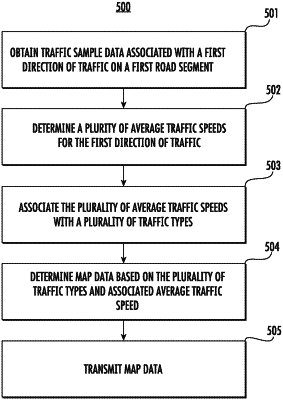| CPC G08G 1/0145 (2013.01) [G08G 1/0112 (2013.01); G08G 1/0133 (2013.01); G08G 1/0141 (2013.01); G08G 1/08 (2013.01); G08G 1/081 (2013.01)] | 20 Claims |

|
1. A computer-implemented method for determining traffic conditions, the method comprising:
obtaining, by one or more computing devices, traffic sample data associated with a first direction of traffic on a first road segment, the traffic sample data including data indicative of a plurality of movement speeds associated with a plurality of objects,
determining, by the one or more computing devices, a plurality of average traffic speeds for the first direction of traffic on the first road segment based at least in part on the plurality of movement speeds,
associating, by the one or more computing devices, each of the plurality of average traffic speeds with at least one of a plurality of traffic types, a first average traffic speed among the plurality of average traffic speeds corresponding to a first traffic type among the plurality of traffic types and a second average traffic speed among the plurality of average traffic speeds corresponding to a second traffic type among the plurality of traffic types;
determining, by the one or more computing devices, map data based at least in part on the plurality of traffic types and associated average traffic speeds; and
in response to receiving a request, transmitting, by the one or more computing devices to a client device, map data corresponding to at least one of the plurality of traffic types for presentation, via a user interface of the client device, to a user associated with the client device.
|